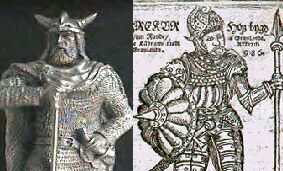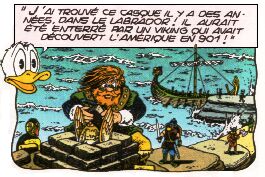- Norwegian Viking Explorer and Hero -
( 935 - 1001 )

- Norwegian Viking Explorer and Hero -
( 935 - 1001 )

| * List of the stories
he appears in :
- W OS 408-02 : "The Golden Helmet", from 1951, by Carl Barks (by name only) ; - D 93287 : "From Duckburg to Lillehammer", from 1994, by Don Rosa (by name only). |
* His biography :
Erik
Thorvaldsson, best known as Erik the Red because of his red
hair, was born in Joederen, Norway around 935, son of Thorvald
Arvaldsson.
His father was exiled from Norway
in 950 because he commited several killings. Because of his age, Erik left
with his father for the coast of Iceland, where he grew up.
He
then became a Norse Chieftain in his clan on the little island of Iceland.
Erik the Red revealed many times through quarrels and life issues that
he possessed a temperament that would lead to trouble. In 981, a serious
quarrel erupted between Erik the Red-haired and his neighbours on Iceland.
In the fight that followed, Erik was responsible for the death of two men.
He was convicted of manslaughter, pronounced an outlaw, and exiled from
Iceland for three years. To stay meant possible death as, once convicted,
anyone on Iceland was allowed to legally kill him.
Desesperate, Erik decided to explore
the West of Iceland, and in 982, along with his family, he discovered a
beautyful and atractive land which he called Greenland, and settled
in it. The Viking settlements in Greenland were established fjords of the
southern and western coast. Erik named his settlement Brattahlid,
which was located on the Ericsfjord. Erik the Redís entire family lived
in total seclusion, but they spent the three years in exile exploring the
south and west coasts of Greenland.
In 985, Erik decides all the same
to turn over to Iceland in order to make share his discovery, and convinced
hundreds of others to join him in settling this new country. In 986, about
25 ships set sail with Erik the Red for Greenland. Only 14 ships
survived the seas, but about 450 new colonists set foot ashore. Erik the
Red continued to reside in the Eastern Settlement, his home, the village
of Brattahlid, and here he raised his children and headed his family. He
had two wives, Thorhild and Thorbjarga, and four sons, Freydis,
Thorvald,
Thorstein,
and Leif Eriksson. Towards
995, Norway is converted to Christianism by King Olaf Trygvason,
and Leif, After an adventurous trip to Norway and an eye opening experience,
now "saved by Christ", returned to his father Erik and tried to convince
him to accept Christianity. Erik refused , but was persuaded by his wife,
Thorhild, to have a church built in their settlement, although he never
visited the finished establishment.
He died in Brattahlid, in his residence
of Greenland in the year 1001.
Leif Eriksson is said to have been
the first European to discover North America.
* His place in the Barks/Rosa stories universe
:
First, in Barks' "The Golden Helmet", his
name is mentionned when Donald finds a map in Duckburg's museum showing
the travels of the drakkar commanded by a Olaf the Blue. The director
of the museum tells that according to a Norwegian legend, this Olaf the
Blue discovered Greenland in 900, long before Eric the Red, and
that he even moored in North America, in 901.
Then, in Rosa's "From Duckburg to Lillehammer",
he is also mentionned when Huey tells, when they are in a trip to Norway
for the Olympic games, that 1 000 years ago, Eric the Red and Olaf
the Blue travelled here...
While Erik the Red is supposed to have really existed
(even if some think it's still a legend), Olaf the Blue is a purely
fictionnal character created by Barks. If he got his nickname after the
color of his hair too, then he would have blue hair and beard :-)
In "Luck of the North" (Barks, 1949), a map is
found by Donald in a viking ship which is said to have been used to find
America before Colombus. It is not told who
used the map. It could be Olaf the Blue, but more likely Leif Eriksson...

Olaf the Blue in Don Rosa's
"The Lost Charts of Columbus"
>>>Back to the real life's characters page
>>> Back to the main page